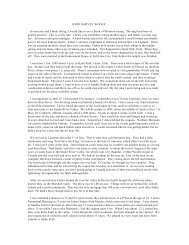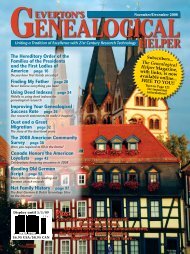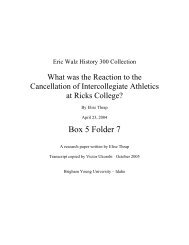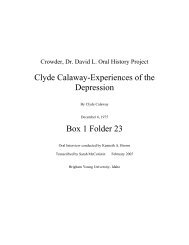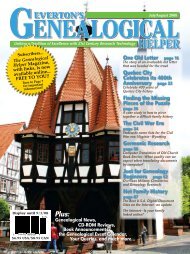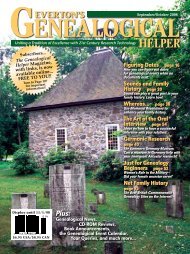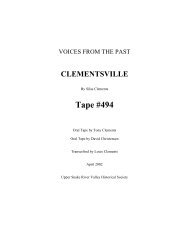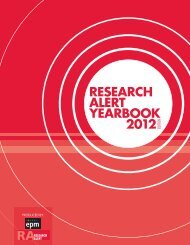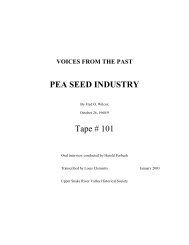HelPeR - BYU Idaho Special Collections and Family History
HelPeR - BYU Idaho Special Collections and Family History
HelPeR - BYU Idaho Special Collections and Family History
You also want an ePaper? Increase the reach of your titles
YUMPU automatically turns print PDFs into web optimized ePapers that Google loves.
01 10<br />
0100010<br />
01010100<br />
Net Famil <strong>History</strong><br />
Tracing Your Swedish Ancestry<br />
This 47 page book by James E. Erickson <strong>and</strong> Nils<br />
William Olson contains images of sample records.<br />
It can be downloaded in pdf format at: http://www.<br />
swedenabroad.se/SelectImage/15063/tracingyourswedishancestry.pdf.<br />
Rötter<br />
www.genealogi.se/roots/<br />
This genealogy portal for the Federation of Swedish<br />
Genealogical Societies is also a rich source of Swedish<br />
genealogical information.<br />
Sweden GenWebProject<br />
http://www.rootsweb.com/~swewgw/<br />
There are numerous links, guides, <strong>and</strong> discussion<br />
boards.<br />
Counties<br />
Sweden is divided into 21 counties (län). Counties<br />
<strong>and</strong> their borders were established by law in 1634.<br />
An interactive map of the counties where you put<br />
the mouse on the county name <strong>and</strong> it highlights the<br />
county can be found at http://www.genline.com/databasen/swedens<br />
lan.php.<br />
Genline’s – Sweden’s Counties Geographically<br />
Language<br />
The following list of Swedish terms was found at<br />
ProGenealogists http://www.progenealogists.com/<br />
sweden/language.htm.<br />
• Birth—född(e)<br />
• Illegitimate—oäkta<br />
• Christening—döpt(e)<br />
• Engagement/Banns—lysnings<br />
• Marriage—vigd(e), gift(e)<br />
• Death—dödde<br />
• Burial—begravd(e)<br />
• County—län<br />
• Parish—socken, församling<br />
• Year—år<br />
• Month—månad<br />
• Day—dag<br />
• Clerical Survey—husförhörslängd<br />
• Moving in—inflyttning<br />
• Moving out—utflyttning<br />
• Probate/Inventory—bouppteckning<br />
‘’y’’ is always used as a vowel <strong>and</strong> pronounced<br />
“I”.<br />
‘’AA’’ <strong>and</strong> ‘’aa’’ are pronounced as in ‘’awe.’’ (Å <strong>and</strong><br />
å are the letters in Sweden.)<br />
‘’Æ’’ <strong>and</strong> ‘’æ’’ are pronounced like in “air.” (Ä <strong>and</strong><br />
ä are the letters in Sweden; but they can be AE or ae<br />
in plain text on the web.)<br />
‘’Ø’’ <strong>and</strong> ‘’ø’’ are pronounced like in ‘’earl.’’ (Ö <strong>and</strong><br />
ö in Sweden; but OE or oe in plain text.)<br />
‘’j’’ is pronounced just like the consonant ‘’y’’ is<br />
said in English.<br />
Records<br />
Fortunately between the Church <strong>and</strong> Civil records<br />
there should be a record of every birth, marriage, <strong>and</strong><br />
death. Unfortunately you need to know the county<br />
<strong>and</strong> parish or town where an event took place <strong>and</strong><br />
the approximate time period in order to be able to<br />
find it.<br />
Civil Records<br />
Civil Registration began in 1860. The records for<br />
birth, marriage, <strong>and</strong> death are similar to the Church<br />
Records.<br />
Church Records<br />
In 1527 the Evangelical Lutheran Church became<br />
the official state church of Sweden. Parishes of the<br />
church were organized throughout the country. In<br />
most places, parish record keeping started in 1686<br />
following an official decree issued by the King of<br />
Sweden to do so.<br />
Parish records are the primary research source<br />
for the years from 1686 to 1860. They usually include<br />
the traditional sources such as Births (Fodde) actually<br />
Christenings, Communion (Conformation), Marriages<br />
(Vigda), <strong>and</strong> Deaths () actually burials. They<br />
can also include other records such as: Household<br />
Examination, Moving In, <strong>and</strong> Moving Out records<br />
as well as Church Accountings.<br />
Genline has the largest collection of digitized<br />
church records. Ancestry also has some available.<br />
The church record descriptions listed below the Genline<br />
samples comes from Ancestry <strong>and</strong> give a good<br />
overview of what the various records contain. In addition<br />
to those described below there may also be:<br />
104 © Ev e r t o n’s Ge n e a l o g i c a l He l p e r Ja n ua ry/Fe b r u a r y 2009



